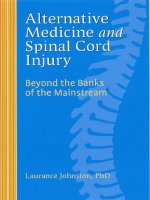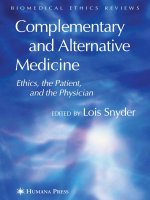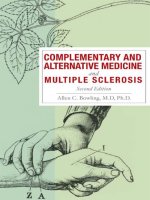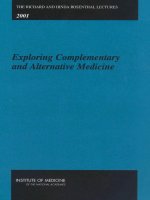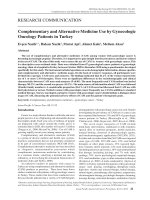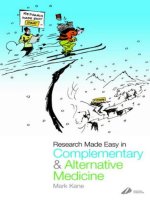Complementary and Alternative Medicine and Psychiatry ppt
Bạn đang xem bản rút gọn của tài liệu. Xem và tải ngay bản đầy đủ của tài liệu tại đây (3.11 MB, 309 trang )
Complementary and
Alternative Medicine and
Psychiatry
Review of Psychiatry Series
John M. Oldham, M.D.
Michelle B. Riba, M.D.
Series Editors
Complementary and
Alternative Medicine and
Psychiatry
EDITED BY
Philip R. Muskin, M.D.
No. 1
Washington, DC
London, England
Note: The authors have worked to ensure that all information in this book
concerning drug dosages, schedules, and routes of administration is accurate as
of the time of publication and consistent with standards set by the U.S. Food and
Drug Administration and the general medical community. As medical research
and practice advance, however, therapeutic standards may change. For this
reason and because human and mechanical errors sometimes occur, we recommend
that readers follow the advice of a physician who is directly involved in their
care or the care of a member of their family.
Books published by the American Psychiatric Press, Inc., represent the views
and opinions of the individual authors and do not necessarily represent the
policies and opinions of the Press or the American Psychiatric Association.
Copyright © 2000 American Psychiatric Press, Inc.
04 03 02 01
5 4 3 2
ALL RIGHTS RESERVED
Manufactured in the United States of America on acid-free paper
American Psychiatric Press, Inc.
1400 K Street, NW
Washington, DC 20005
www.appi.org
The correct citation for this book is
Muskin PR (ed.): Complementary and Alternative Medicine and Psychiatry
(Review of Psychiatry Series, Vol. 19, No. 1; Oldham JM and Riba MB,
series eds.). Washington, DC, American Psychiatric Press, 2000
Library of Congress Cataloging-in-Publication Data
Complementary and alternative medicine and psychiatry /
edited by Philip R. Muskin
p. ; cm. — (Review of psychiatry ; v. 19, no. 1)
Includes bibliographical references and index.
ISBN 0-88048-174-9 (alk. paper)
1. Alternative medicine. 2. Psychiatry. I. Muskin, Philip R. II. Review of
Psychiatry series ; v. 19, 1.
[DNLM: 1. Alternative Medicine. 2. Psychiatry—methods.
3. Psychotherapy—methods.
WB 890 C7366 2000]
R733.C6528 2000
615.5—dc21
British Library Cataloguing in Publication Data
A CIP record is available from the British Library.
Review of Psychiatry Series ISSN 1041-5882
Contents
Contributors
Introduction to the Review of Psychiatry Series
John M. Oldham, M.D.
Michelle B. Riba, M.D., Series Editors
Introduction: Herbs and Hermeneutics
Philip R. Muskin, M.D.
Chapter 1
Integrative Psychopharmacology: A Practical
Approach to Herbs and Nutrients in Psychiatry
Richard P. Brown, M.D.
Patricia L. Gerbarg, M.D.
General Issues Related to the Use of
Complementary and Alternative Compounds
Mood Disorders
Anxiety
Insomnia
Migraine
Endocrine and Reproductive Systems
Sexual Enhancement
Cognitive Enhancement
Obesity
Herb–Drug Interactions
Athletic Enhancement
Physician Education
References
Chapter 2
Acupuncture for Mental Health
Francine Rainone, D.O.
Overview of Traditional Chinese Medicine
Pathophysiology
Categories of Disease Process
Role of Emotions
ix
xi
xv
1
2
3
18
21
23
24
35
38
46
47
48
48
49
67
68
74
76
78
Traditional Chinese Medicine in Practice
Acupuncture and Biomedical Research
Psychiatry and Culture
Research on Acupuncture
Methodologic Problems
Treatment Protocols
Controls in Acupuncture Research
Future Directions
References
Chapter 3
Uses of Yoga in Psychiatry and Medicine
Ina Becker, M.D., Ph.D.
The History of Yoga
Obstacles to the Use of Yoga in Western Medicine
Philosophy of Yoga
Psychology of Yoga
The Eight Limbs of Yoga
Yoga in Health and Prevention
Yoga and Psychiatry
Psychiatric Indications for Yoga
Psychiatric Disturbances Caused by Yoga
Medical Indications for Yoga
Injuries From Yogic Exercise
Conclusions
Resources
References
Chapter 4
Meditation and Psychotherapy: Stress,
Allostasis, and Enriched Learning
Joseph Loizzo, M.D., M.Phil.
Meditation in Medicine,
Neuroscience, and Psychiatry
From Meditation to Psychotherapy:
The Bridge of Hypnotic Learning
81
85
86
88
94
95
97
100
102
107
107
109
111
114
117
124
126
130
134
135
139
139
141
142
147
147
149
From Trauma to Enrichment:
Stress, Learning, and the Brain
Meditation and Psychotherapy:
Two Methods of Enriched Learning
Research, Teaching, and
Clinical Uses of Meditation
References
Chapter 5
Complementary Medicine: Implications Toward
Medical Treatment and the Patient–Physician
Relationship
Catherine C. Crone, M.D.
Thomas N. Wise, M.D.
Definition of Complementary and
Alternative Medicine
Categories of CAM
General Trends
CAM Users
Physicians and CAM
CAM and Medical Illness
CAM and Chronic Illness
CAM and Life-Threatening Illness
CAM and the Patient–Physician Relationship
References
157
161
170
181
199
200
200
201
204
205
206
210
221
230
232
Afterword
Philip R. Muskin, M.D.
241
Index
245
This page intentionally left blank
Contributors
Ina Becker, M.D., Ph.D.
Assistant Director, Center for Meditation and Healing, Columbia
University; Assistant Professor of Clinical Psychiatry, Columbia
University College of Physicians & Surgeons, New York, New York
Richard P. Brown, M.D.
Associate Professor of Clinical Psychiatry, Columbia University
College of Physicians & Surgeons, New York, New York
Catherine C. Crone, M.D.
Director, Consultation-Liaison Psychiatry Fellowship, Department of
Psychiatry, Inova Fairfax Hospital/Georgetown University, Falls
Church, Virginia; Assistant Clinical Professor, Department of
Psychiatry, Georgetown University Medical Center, Washington, DC
Patricia L. Gerbarg, M.D.
Assistant Clinical Professor of Psychiatry, New York Medical College,
New York, New York
Joseph Loizzo, M.D., M.Phil.
Founder and Director, Clinical Center for Meditation and Healing,
Columbia-Presbyterian Eastside; Assistant Professor of Clinical
Psychiatry, Columbia University College of Physicians & Surgeons;
Presidential Fellow in Indo-Tibetan Studies, Columbia University
Graduate School of Arts and Sciences, New York, New York
Philip R. Muskin, M.D.
Chief, Consultation-Liaison Psychiatry, Columbia-Presbyterian
Medical Center; Associate Professor of Clinical Psychiatry, Columbia
University College of Physicians & Surgeons; and Faculty, Columbia
University Psychoanalytic Center for Training and Research, New
York, New York
John M. Oldham, M.D.
Director, New York State Psychiatric Institute; Dollard Professor and
Acting Chairman, Department of Psychiatry, Columbia University
College of Physicians and Surgeons, New York, New York
COMPLEMENTARY AND ALTERNATIVE MEDICINE AND PSYCHIATRY
ix
Francine Rainone, D.O.
Department of Family Medicine, Department of Pain Medicine and
Palliative Care, Coordinator or Curriculum in Complementary and
Alternative Medicine, Director of Continuing Medical Education in
Complementary and Alternative Medicine, and Residency Program
in Urban Family Health, Beth Israel Medical Center; Assistant
Professor of Family Medicine, Albert Einstein College of Medicine,
New York, New York
Michelle B. Riba, M.D.
Clinical Associate Professor of Psychiatry and Associate Chair for
Education and Academic Affairs, Department of Psychiatry,
University of Michigan Health System, Ann Arbor, Michigan
Thomas N. Wise, M.D.
Chairman, Department of Psychiatry, Inova Fairfax Hospital, Falls
Church, Virginia; Vice Chairman and Professor, Department of
Psychiatry, Georgetown University Medical Center, Washington, DC;
Professor, Department of Psychiatry, Johns Hopkins University
School of Medicine, Baltimore, Maryland
x
COMPLEMENTARY AND ALTERNATIVE MEDICINE AND PSYCHIATRY
Introduction to the Review
of Psychiatry Series
John M. Oldham, M.D.
Michelle B. Riba, M.D., Series Editors
2000 REVIEW OF PSYCHIATRY SERIES TITLES
•
•
•
•
•
Learning Disabilities: Implications for Psychiatric Treatment
EDITED BY LAURENCE L. GREENHILL, M.D.
Psychotherapy for Personality Disorders
EDITED BY JOHN G. GUNDERSON, M.D., AND GLEN O.
GABBARD, M.D.
Ethnicity and Psychopharmacology
EDITED BY PEDRO RUIZ, M.D.
Complementary and Alternative Medicine and Psychiatry
EDITED BY PHILIP R. MUSKIN, M.D.
Pain: What Psychiatrists Need to Know
EDITED BY MARY JANE MASSIE, M.D.
The advances in knowledge in the field of psychiatry and the
neurosciences in the last century can easily be described as breathtaking. As we embark on a new century and a new millennium,
we felt that it would be appropriate for the 2000 Review of Psychiatry Series monographs to take stock of the state of that knowledge at the interface between normality and pathology. Although
there may be nothing new under the sun, we are learning more
about not-so-new things, such as how we grow and develop; who
we are; how to differentiate between just being different from one
another and being ill; how to recognize, treat, and perhaps prevent
illness; how to identify our unique vulnerabilities; and how to
deal with the inevitable stress and pain that await each of us.
In the early years of life, for example, how can we tell whether
a particular child is just rowdier, less intelligent, or more advenCOMPLEMENTARY AND ALTERNATIVE MEDICINE AND PSYCHIATRY
xi
turesome than another child—or is, instead, a child with a learning
or behavior disorder? Clearly, the distinction is crucial, because
newer and better treatments that now exist for early-onset disorders can smooth the path and enhance the chances for a solid future for children with such disorders. Yet, inappropriately labeling
and treating a rambunctious but normal child can create problems
rather than solve them. Greenhill and colleagues guide us through
these waters, illustrating that a highly sophisticated methodology
has been developed to make this distinction with accuracy, and
that effective treatments and interventions are now at hand.
Once we have successfully navigated our way into early adulthood, we are supposed to have a pretty good idea (so the advice
books say) of who we are. Of course, this stage of development
does not come easy, nor at the same time, for all. Again, a challenge
presents itself—that is, to differentiate between widely disparate
varieties of temperament and character and when extremes of personality traits and styles should be recognized as disorders. And
even when traits are so extreme that little dispute exists that a
disorder is present, does that disorder represent who the person
is, or is it something the individual either inherited or developed
and might be able to overcome? In the fifth century B.C., Hippocrates described different personality types that he proposed were
correlated with specific “body humors”; this ancient principle remains quite relevant, though the body humors of today are neurotransmitters. How low CNS serotonin levels need to be, for
example, to produce disordered impulsivity is still being determined, yet new symptom-targeted treatment of such conditions
with SSRIs is now well accepted. What has been at risk as the
neurobiology of personality disorders has become increasingly
understood is the continued recognition of the importance of psychosocial treatments for these disorders. Gunderson and Gabbard
and their colleagues review the surprisingly robust evidence for
the effectiveness of these approaches, including new uses and
types of cognitive-behavioral and psychoeducational methods.
It is not just differences in personality that distinguish us from
one another. Particularly in our new world of global communication and population migration, ethnic and cultural differences are
more often part of life in our own neighborhoods than just exotic
xii
COMPLEMENTARY AND ALTERNATIVE MEDICINE AND PSYCHIATRY
and unfamiliar aspects of faraway lands. Despite great strides
overcoming fears and prejudices, much work remains to be done.
At the same time, we must learn more about ways that we are
different (not better or worse) genetically and biologically, because
uninformed ignorance of these differences leads to unacceptable
risks. Ruiz and colleagues carefully present what we now know
and do not know about ethnicity and its effects on pharmacokinetics and pharmacodynamics.
An explosion of interest in and information about wellness—
not just illness—surrounds us. How to achieve and sustain a
healthy lifestyle, how to enhance successful aging, and how to
benefit from “natural” remedies saturate the media. Ironically, although this seems to be a new phenomenon, the principles of complementary or alternative medicine are ancient. Some of our oldest
and most widely used medications are derived from plants and
herbs, and Eastern medicine has for centuries relied on concepts
of harmony, relaxation, and meditation. Again, as the world
shrinks, we are obligated to be open to ideas that may be new to
us but not to others and to carefully evaluate their utility. Muskin
and colleagues present a careful analysis of the most familiar and
important components of complementary and alternative medicine, presenting a substantial database of information, along with
tutorials on non-Western (hence nontraditional to us) concepts
and beliefs.
Like it or not, life presents us with stress and pain. Pain management has not typically figured into mainstream psychiatric
training or practice (with the exception of consultation-liaison
psychiatry), yet it figures prominently in the lives of us all. Massie
and colleagues provide us with a primer on what psychiatrists
should know about the subject, and there is a great deal indeed
that we should know.
Many other interfaces exist between psychiatry as a field of
medicine, defining and treating psychiatric illnesses, and the rest
of medicine—and between psychiatry and the many paths of the
life cycle. These considerations are, we believe, among our top
priorities as we begin the new millennium, and these volumes
provide an in-depth review of some of the most important ones.
COMPLEMENTARY AND ALTERNATIVE MEDICINE AND PSYCHIATRY
xiii
This page intentionally left blank
Introduction:
Herbs and Hermeneutics
Philip R. Muskin, M.D.
“There are more things in heaven and earth, Horatio, than are
dreamt of in your philosophy”
Hamlet Act 1, scene 5
W
hat is alternative medicine? Attempts to define what is conventional and what is not conventional introduce a bias, no matter
who the arbiter is who sets up the definitions (Table 1). Many
alternative therapies pre-date conventional medicine by hundreds or thousands of years. Some are quite well known, others
seem mysterious or strange, and some pose serious risks (Murray
and Rubel 1992). Many of us use unconventional therapies acquired from grandparents, parents, or friends (chicken soup is
perhaps the most famous) in our personal lives without a second
thought. In some circles alternative medicine is completely dismissed (Funtanarosa and Lundberg 1998). Yet those who contend
that alternative therapies have no value may be guilty of failing
to adhere to one of the core aphorisms of medicine, that is, “Never
say never.” Special diets, ritualistic practices, gleaning information about people in unconventional ways, healing based on energy fields or aromas, and other unusual methods may cause
some physicians to warn patients away from complementary and
alternative medicine (CAM). Is it pure science that supports our
faith in “allopathic” medicine, or do the character traits that many
physicians possess influence our rejection of what seems to be less
well substantiated therapies (Gabbard 1985)?
What differentiates CAM approaches from conventional, or allopathic, medicine is the idea of using the individual’s own resources as well as energy within and outside of the person in order
to maintain wellness. There is a belief that the body can heal itself,
using energy mobilized by external manipulations. The central
focus is the individual, not the doctor or the treatment. The unique
COMPLEMENTARY AND ALTERNATIVE MEDICINE AND PSYCHIATRY
xv
Table 1.
Types of complementary and alternative medicine
Body
Mind
Spirit
Acupuncture
Aikido
Air therapy
Alexander method
Adlerian analysis
Alexandrian analysis
Astrology
Bach’s flower
remedies
Bioenergetics
Absent healing
Catholic healers
Edgar Cayce
Christian Science
Biofeedback training
Direct decision
therapy
Ericksonian analysis
est
Existent analysis
Frommian analysis
Gestalt therapy
Graphology
Hornevian therapy
Imagery
Jungian analysis
Logotherapy
(Victor Frankl)
Maslovian analysis
Mensendick system
Moxibustion
Music therapy
Naprapathy
Naturopathy
Osteopathy
Phrenology
Eckankar
Enlightened healing
Apple cider vinegar and
honey (D. D. Jarvis, M.D.)
Ayurvedic medicine
Biochemics
Bioelectromagnetics
Chinese remedial therapy
Chiropody
Chiropractic
Color therapy
Coué’s autosuggestion
Dance therapy
Earth therapy
Feldenkrais
Gravitonics
Herbalism
Homeopathy
Hypnosis
Ionization
Iriodology
Japanese massage
Kneipp’s water therapy
Lakhovsky oscillatory
coils
Lotte Berk method
Massage
Sleep therapy
Spiritual healing
Structural integration
(Rolfing)
Tai chi ch’uan
Tantric medicine
Unani medicine
xvi
Contact healing
Evangelistic healing
Gurdjieff
Meditation
Mind power
Palmistry
Paradox therapy
Pecci-Hoffman therapy
Primal therapy
Radiesthesia
Rankian therapy
Rational therapy
Reichian therapy
Reikian analysis
Scientology
Spiritualists
Sullivanian analysis
Transactional analysis
Yoga
Phrenosophical
Zen
spiritual healing
Polarity therapy
Radiesthesia
Reich’s orgonic therapy
Rikli’s sunshine cure
Sauna
Sex therapy
Shiatsu massage
COMPLEMENTARY AND ALTERNATIVE MEDICINE AND PSYCHIATRY
Table 1.
Types of complementary and alternative medicine (continued)
Body
Mind
Vitamin therapy
Yoga
Zen macrobiotics
Visualization
Source.
Spirit
LaPatra 1978
quality of the whole person in alternative therapies makes the
concepts of standardization, quantification, generalization, and
normalization problematic for both research and clinical activity
in comparison with conventional medicine. In allopathic medicine, the treatment acts on the person, who plays no active role
beyond cooperation with the treatment regimen; the knowledge
rests with the doctor. In alternative medicine, the knowledge and
beliefs are shared by patients and practitioners with a focus on
what is unique about the patient and on his or her role in selfhealing. In CAM, natural products, plants, and nutrients all play
an important role, because the body exists in an environment from
which it is designed to obtain energy, stay healthy, and get well.
When we look back at some of the claims made by proponents
of certain therapies, they may seem absurd, even frightening. Yet
not all of the ideas are unworthy of consideration. For example,
in 1839 Sylvester Graham, a Presbyterian minister, espoused the
value of dietary measures for good health in two volumes entitled
Lectures on the Science of Life. Graham blamed American dyspepsia
on fried meat, alcohol, eating too fast, and the use of “unnatural”
refined wheat flour. He urged people to eat fruits, vegetables, and
unsifted whole wheat flour (graham flour) in bread that is slightly
stale and to chew thoroughly to promote good digestion, prevent
alcoholism, and diminish the sex urge. Graham’s teaching came
from his religious beliefs that all pleasurable sensation was Satanic
in origin and that immoral behavior resulted in poor health. Adherents of Graham’s philosophy did not eat meat, drank a lot of
water, bathed regularly, and believed corsets and neckties were
bad for them—not a particularly bad way to live. In addition, graham flour was an important ingredient in the graham crackers
COMPLEMENTARY AND ALTERNATIVE MEDICINE AND PSYCHIATRY
xvii
they ate. In our modern world, would we not be worse off without
the pleasure of a “s’more”(graham cracker, roasted marshmallow,
and chocolate) at a campfire cookout?
When we question the efficacy of a dose of medication seemingly too small to have a clinical effect, we label it as a homeopathic
dose. Homeopathy derives from a principle voiced by Hippocrates in 400 B.C., similia similibus curantur, or “like cures like.”
Samuel Hahnemann founded homeopathy in 1796, and it once
enjoyed great worldwide popularity. A central principle of homeopathy is that a person with an illness can be cured by a substance
that causes symptoms similar to that illness. Homeopaths contend
that minuscule quantities of the substance will bring out the
body’s natural healing mechanisms and thus dilute the material
until only infinitesimal quantities are left in solution. Critics of
homeopathy are both new and old. In 1999, The Medical Letter concluded “there is no good reason to use” homeopathic products
(“Homeopathic products” 1999). One hundred fifty-seven years
earlier, Oliver Wendell Holmes delivered two lectures to the Boston Society for the Diffusion of Useful Knowledge entitled, “Homeopathy and Its Kindred Delusions.” He commented, “I think
it fair to conclude that the catalogues of symptoms attributed
in Homeopathic works to the influence of various drugs upon
healthy persons are not entitled to any confidence” (Holmes 1985).
If everyone had followed Holmes regarding homeopathic principles, then no one would have taken the letter by Reverend Edmund Stone to the Royal College of Physicians seriously. He
described “an account of the success of the bark of the willow in
the cure of agues” (Insel 1996). Because willow grows in swamps
where agues (fevers) are known to occur, Reverend Stone thought
that willow would have curative powers for fevers. In 1829, salicin
was isolated from willow bark. Felix Hoffman, a chemist with the
Bayer Corporation, synthesized acetylsalicylic acid in the later
part of the 1800s. In 1905 this was marketed by Bayer as aspirin, a
name derived from Spiraea, a plant from which salicylic acid was
prepared. Thus the discovery of aspirin, one of the wonder drugs
of the twentieth century, was directly related to homeopathic principles, and the substance was derived from a botanical product in
use for hundreds of years by native peoples.
xviii
COMPLEMENTARY AND ALTERNATIVE MEDICINE AND PSYCHIATRY
It is difficult not to throw out the ”baby” of efficacious alternative treatments with the ”bath water” of the failure to substantiate
many of the claims regarding alternative therapies. Many important treatments derive from natural substances, including Taxol
and several other antineoplastics. Natural-product drugs comprise 34% of the 25 best-selling drugs (Service 1999). Penicillin
started out as a mold. The leaves of the foxglove plant (Digitalis
purpurea) contain digitoxin and were used more than 300 years
ago for the treatment of dropsy (edema related to congestive heart
failure). If we dismiss the value of the natural world, other effective treatments—both biological and psychological—might not
be discovered. Ten years ago there was much excitement about
finding new treatments from natural sources. The cost of finding,
isolating, purifying, and testing natural substances is so high that
some companies have abandoned the search and instead use combinational chemistry to synthesize thousands of compounds and
then screen them for potential drugs (Service 1999). Many companies, however, continue the search for natural products, using
improved technology to purify and analyze compounds or isolating natural products from microorganisms (Service 1999). Those
who are open minded toward natural products may believe in
two widely held notions, that natural is safer and that natural is
better than conventional treatments. Neither of these approaches
is completely true.
Natural is not always safer. Botanical products are not subject
to the stringent regulations of the U.S. Food and Drug Administration. Although claims may be made in advertisements or by
celebrities, these products are not medications but are dietary supplements. The consumer may or may not be getting what he or
she expects in the preparation. Botanical dietary supplements are
regulated under the Dietary Supplement Health and Education
Act of 1994, which does not require that the substance be shown
to be safe and effective for the indication (Slifman et al. 1998).
Serious and potentially lethal contamination of botanical supplements is possible and has occurred (Slifman et al. 1998). MuTong,
a Chinese herbal tea used for eczema, has caused renal failure
requiring kidney transplant (Lord et al. 1999). This condition apparently results from failure to accurately pick the plant from
COMPLEMENTARY AND ALTERNATIVE MEDICINE AND PSYCHIATRY
xix
which the tea is prepared. As those with a garden know well, in
some years a particular plant may grow well, but not every year.
Thus the herbal preparation may contain none, some, or too much
of the ingredient that yields the desired therapeutic effect. Preparations found in health food stores may contain little of the
“active” substance (Davidson 1999). Although some adverse
herb–drug reactions have been described, interactions between
“natural” products and medications are unknown for the most
part, leading to potentially adverse reactions (Yager 1999). Some
patients may tell their physicians of their use of alternative therapies, but not 100% of patients. Herbs have the potential to cause
adverse interactions with anesthesia (Nagourney 1999), particularly problematic if the physician is unaware of the patient’s use
of an herbal preparation. Ginkgo biloba and Allium sativum (garlic)
may both result in bleeding if taken along with anticoagulants
(Brody 1999, Calvo 1999). Hypericum perforatum (St. John’s wort),
Ginkgo biloba, and Echinacea purpurea have been shown to be damaging to reproductive cells in animal studies (Ondrizek et al. 1999).
St. John’s wort may induce hepatic enzymes to metabolize other
drugs such as indinavir more quickly (Piscitelli et al. 2000). This
could reduce the effectiveness of medications used to treat AIDS
or prevent transplant rejection. These concerns are particularly
important when St. John’s wort is used as an alternative to antidepressant treatment without medical supervision and when
ginkgo is recommended as adjunctive therapy for patients experiencing sexual dysfunction secondary to treatment with traditional antidepressants (Cohen and Bartlik 1998). Ephedra (ma
huang), used as a stimulant and decongestant, has been linked to
over 38 deaths (“Herbal Rx” 1999). Patients taking psychiatric
drugs may add on alternative therapies that produce toxicity, benefit, or confuse both patient and physician as to which substance
was the therapeutic agent (Yager et al. 1999). There is little to support the notion of natural substances carrying a greater degree of
safety than pharmaceutical products. If the substances are effective, they are drugs in a natural form. All drugs have the potential
to cause harm.
Alternative therapies are not new and in using them we have
now gone full circle back to more primitive forms of treatment.
xx
COMPLEMENTARY AND ALTERNATIVE MEDICINE AND PSYCHIATRY
Alternative therapies have always been there, and people have
always used them. The concept of a vital energy is found in homeopathy (spiritual vital force), chiropractic (innate energy), psychic
healing (auric, psionic), acupuncture (qi), ayurvedic medicine (prana),
or naturopathy (vis medicatrix naturae) (Kaptchuk 1996). There is a
belief in forces, invisible but powerful, that exert an effect on us
all and must be used to maintain wellness and restore health. If
the concept of vitalism is traced from its Aristotelian and Asian
roots, the path leads through Mesmer’s animal magnetism,
Rhine’s parapsychology, von Reichenbach’s odic force of crystal
healing, and Quimby’s Mind Cure. In Mind Cure, disease is
thought to be the product of wrong thinking. Meditation, relaxation, and deep breathing help autosuggestion that would result
in cure. One of Quimby’s students (and patients) was Mary Baker
Eddy, who established Christian Science. She espoused the belief
that all illness is illusion.
D. D. Palmer was an American mesmeric healer who used hand
passes and magnetic spine rubs. In 1895 he had the insight that
“putting down your hands”—that is, making mechanical adjustments—worked better than the “laying on of hands.” He thus
invented chiropractic medicine with the theory that disease derives from too much or too little energy. Spinal alignment frees
the nerves to allow innate energy to produce healing. Today, chiropractic medicine is licensed in all 50 states.
Alternative medicine includes another energy that is not connected to either mesmerism or vitalist notions, that is, the healing
force of nature or vis medicatrix naturae put forward by William
Cullen in 1772. This healing energy of nature formed the foundation of the herbalist movement, although herbs had been used for
hundreds of years or more by native peoples. The movement became popular in the United States in the 1700s and 1800s with the
creation of herbalist medical schools but waned after the last herbal medical school closed in 1939. The herbalist approach also became popular in Europe, where it remains strong even today.
Asian concepts of vital energy (qi), part of acupuncture and other
disciplines, became popular in the 1960s in the United States. Animate and inanimate matter is said to possess qi. With these new
concepts come new types of massage, such as shiatsu; new concepts
COMPLEMENTARY AND ALTERNATIVE MEDICINE AND PSYCHIATRY
xxi
of energy, such as reiki johrei; and new forms of meditation.
The concept of vital energy went in many directions. In 1843
James Braid postulated that mesmerism had its effects via a mental
force that he named hypnosis. This notion was taken up and explored by Charcot and Bernheim, with whom Freud studied.
Freud used hypnosis in his early work, and this formed the foundation for his psychoanalytic theory, which informed the psychotherapies that use psychodynamic concepts. The fusion of the
concepts of hypnosis, autogenic training (specific self-instructions
to relax), and guided imagery with the work of Pavlov, Watson,
and Thorndike led to the creation of biofeedback. Biofeedback uses
the person’s ability to self-train and control internal physiologic
responses in order to treat illness and maintain wellness. These
concepts led Benson to conceptualize the Relaxation Response. In
the 1920s the term holistic medicine was coined by J. C. Smuts, a
South African statesman. The term was both antivitalist and antimechanistic. This antireductionist approach contends that the
whole of the organism cannot be explained by its parts. Later antireductionists in biomedicine such as Cannon, Seyle, Dunbar, and
Engels focused on people’s predispositions, psychosocial factors,
and homeostasis. From an ancient belief in the vital energy of all
things, a concept that might be rejected as unscientific and unprovable, we arrive at concepts that are part of our everyday work.
In tracing the history of vital energy and alternative medicine it
becomes difficult to know what is alternative to what.
Is natural better? This is a question of perspective, because there
is no scientific evidence to support this belief. A meta-analysis of
trials of St. John’s wort indicated that it is more effective than placebo for mild to moderate depression (Gaster et al. 2000; Linde et
al. 1996). There have been many critiques of this literature, particularly questioning the high placebo response rate and the low
doses of comparison antidepressants used. Trials comparing St.
John’s wort with traditional antidepressants in the United States
are under way. Early on in the history of the selective serotonin
reuptake inhibitors (SSRIs)—as recently as 1989—people asked
similar questions about this new class of drugs. If a patient uses
an alternative therapy and recovers, and this treatment is psychologically more acceptable than a conventional treatment that the
xxii
COMPLEMENTARY AND ALTERNATIVE MEDICINE AND PSYCHIATRY
person would not have undertaken, how do we then define better?
What defines natural? Any treatment that exerts an effect psychologically, whether good or bad, must do so via the brain. Wherever
the mind is, one must first go through the brain to get to the mind.
From a narrow perspective, therapies that employ talk as the central element are all “natural,” whatever the theory that informs
the therapy, because humankind has sought to understand itself
for as long as there has been recorded history. Successful therapy
employing talk has been shown to change the functioning of the
brain, as demonstrated by positron-emission tomography (PET)
scans (Schwartz et al. 1996). If talk is natural but works to change
the brain, there is a blurring of the distinction between therapies
that conventional physicians might call alternative and those they
view as traditional. Patients, however, seem to take to these alternative therapies much more readily than do some physicians.
Some of the popularity of these therapies comes from their reputation; we have heard about the benefits, know of someone who
has benefited, or have personally experienced a benefit from some
alternative treatment. In some cases the treatment actually has
exerted a therapeutic effect, even if the mechanism is unknown.
St. John’s wort, now under consideration as an antidepressant, is
also a folk remedy for skin injuries and burns. Highly purified
extracts of Hypericum perforatum demonstrate antibacterial properties (Schempp et al. 1999). In preantibiotic times, an extract of
St. John’s wort might well have prevented an infection when applied to burns or wounds. Because no treatment, conventional or
alternative, works 100% of the time, even occasional successes
build the reputation of efficacy. On the other hand, the plural of
anecdote is not data.
Another factor influencing the positive reputation of alternative
therapies is the placebo effect. Placebo, or “I shall please,” was defined in 1785 as a “commonplace method or medicine” (Straus and
von Ammon Cavanaugh 1996). We attribute the efficacy of a treatment that lacks a known mechanism or theory of action to beliefs
that the culture chooses to overlook (Hahn 1985). The power of placebo cannot be ignored, however, although we might wish that it
remain confined to alternative treatments. There is the possibility
of a placebo response as a minor or major effect even when an “acCOMPLEMENTARY AND ALTERNATIVE MEDICINE AND PSYCHIATRY
xxiii
tive” treatment is undertaken. Placebo responders occur in every
drug trial. Even in a study of lowering cholesterol, patients in the
placebo group had a lower mortality rate as long as they were compliant with the placebo (Coronary Drug Project Group 1980). When
subjects have experience with a substance (in this instance alcohol),
their belief that they have received the active substance equals the
effect of the active substance itself (Himie et al. 1999). The expectations of patient and doctor regarding a treatment influence the outcome, positively and negatively (Smith and Thompson 1993).
Nocebo, or “I shall harm,” responses also occur and are well-known
in drug trials in patients receiving active and placebo treatments.
The power of the mind must always be respected in its control
over both psyche and soma. Thus, in pharmacologic and nonpharmacologic therapies, whether alternative or conventional, the
patient’s, practitioner’s, family’s, and culture’s emotions and fantasies influence the outcome. A recent meta-analysis of antidepressants suggested that the placebo response accounts for 75%
of the response in drug trials (Kirsch and Sapirstein 1998). Although this controversial critique raises important questions,
most physicians who use medications contend that there are pharmacologic effects that have produced great benefit for patients.
How powerful can the mind be? Our clinical experience exposes
us to the devastating power of the mind in psychiatric disorders.
Some would discount therapies that rely on the alteration of energy, mediation, or spirituality. How can we explain the prolonged
survival of women with cancer who participate in supportive
group therapy? (See Fawzy et al. 1993; Spiegel et al. 1989.) Seemingly impossible achievements can occur with desire and practice.
To use an example outside of the alternative medicine field: studies of karate demonstrated that a well-trained karateka (practitioner of karate) kicks at speeds of greater than 21,000 mph (Feld
et al. 1979). The power generated in a karate punch is equivalent
to the energy necessary to lift a 1-ton weight several inches off the
floor (Feld et al. 1979). Is it impossible that a person’s focus of
internal resources could not be used to exert a healing effect, even
if we do not understand the mechanism?
Data from a telephone survey of 2,055 adults in 1997 formed
the basis of an estimate that $21.2 billion to $32.7 billion are spent
xxiv
COMPLEMENTARY AND ALTERNATIVE MEDICINE AND PSYCHIATRY
